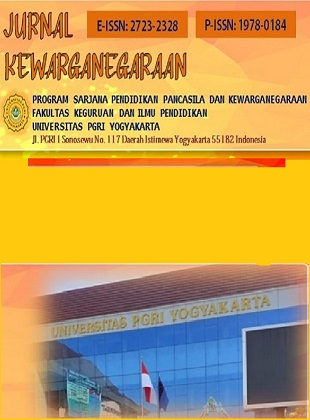Keefektifan Metode Matematika Gasing Dalam Meningkatkan Kemampuan Pemahaman Konsep Matematis Perkalian Dua Digit Untuk Siswa Kelas VI SD
DOI:
https://doi.org/10.31316/jk.v6i2.3038Abstract
Abstrak
Penelitian ini bertujuan untuk menguji keefektifan metode Matematika Gasing dalam meningkatkan kemampuan pemahaman konsep matematis siswa dalam materi perkalian dua digit. Penelitian ini dilatarbelakangi oleh rendahnya hasil tes harian Matematika khususnya pada materi perkalian dua digit di kelas VI A dan VI B SDN Bokong 2. Hasil dari tes harian ini sebanyak 66% siswa mendapat nilai tidak tuntas KKM dari jumlah seluruh siswa 30 anak. Hal ini menunjukkan bahwa kemampuan pemahaman konsep matematis siswa masih rendah terutama dalam konsep perkalian. Jenis penelitian yang digunakan yaitu Quasi Experimental Design dengan desain penelitian Nonequivalent Control Group Design. Instrumen dalam penelitian ini berupa hasil tes belajar siswa topik perkalian dua digit dan observasi pelaksanaan pembelajaran menggunakan metode Matematika Gasing dengan metode konvensional. Hasil dari penelitian ini terdapat perbedaan rata-rata nilai posttest kelas VI A yang menggunakan metode konvensional sebesar 29,73 dengan kelas VI B yang menggunakan metode Gasing sebesar 35,00. Dengan kata lain, metode Matematika Gasing efektif digunakan untuk meningkatkan kemampuan pemahaman konsep matematis siswa terutama pada materi perkalian dua digit.
Kata Kunci: Matematika Gasing, Kemampuan pemahaman konsep matematis, Perkalian dua digit
Â
Abstract
This study aims to test the effectiveness of the Mathematical Gasing method in improving students' ability to understand mathematical concepts in two-digit multiplication material. This research was motivated by the low results of the daily Mathematics test, especially in the double-digit multiplication material in grades VI A and VI B SDN Bokong 2. The results of this daily test were 66% of students scored incomplete KKM out of a total of 30 students. This shows that students' ability to understand mathematical concepts is still low, especially in the concept of multiplication. The type of research used is Quasi Experimental Design with the research design of Nonequivalent Control Group Design. The instruments in this study were the results of student learning tests on the topic of double-digit multiplication and observations of the implementation of learning using the Gasing Mathematics method with conventional methods. The results of this study there is a difference in the average posttest value of class VI A using the conventional method of 29.73 with class VI B using the Gasing method of 35.00. In other words, the Mathematical Gasing method is effectively used to improve students' ability to understand mathematical concepts, especially in the two-digit multiplication material.
Keywords: Math Gasing, Ability to understand mathematical concepts, Multiplication of two digitsReferences
DAFTAR PUSTAKA
Arikunto, S. (2013). Prosedur Penelitian Suatu Pendekatan Praktek. Jakarta: Rineka Cipta.
Armianti, A., Yani, I., Widuri, K., & Sulistiawati, S. (2016). Pengaruh Matematika GASING (Gampang, ASyIk, dan menyenaNGkan) pada Materi Perkalian Bilangan Bulat Terhadap Hasil Belajar Peserta Matrikulasi STKIP Surya. Kreano, Jurnal Matematika Kreatif-Inovatif, 7(1), 74-81.
Delima, I. (2019). Pengaruh Model Pembelajaran Tgt (Teams Games Tournament) Modifikasi Metode Gasing Terhadap Kemampuan Pemecahan Masalah Matematis Peserta Didik Kelas Vii Smp Negeri 36 Bandar Lampung (Doctoral dissertation, UIN Raden Intan Lampung).
Husnah, R. (2017). Pengaruh Model Pembelajaran Koopratif Tipe Kepala Bernomor Struktur Terhadap Hasil Belajar Siswa Pada Mata Pelajaran Matematika Kelas V di MI Inayatullah Gasing (Doctoral dissertation, UIN RADEN FATAH PALEMBANG).
Isrokatun, I., Hanifah, N., Maulana, M., & Suhaebar, I. (2020). Pembelajaran Matematika dan Sains secara Integratif melalui Situation-Based Learning. UPI Sumedang Press
Kartika, A. W. (2020). Komparasi Model Pembelajaran Problem Based Learning Dan Discovery Learning Ditinjau Dari Peningkatan Kemampuan Pemecahan Masalah Matematika Siswa SD. Wahana Sekolah Dasar, Vol. 28, No 2 (Juli 2020), Hal. 42-50
Mulyawati, I., & Sarwinda, W. (2020). IbM Workshop Metode Matematika Gasing Bagi Guru SD Muhammadiyah Se Jakarta Timur. Jurnal Pengabdian Masyarakat MIPA dan Pendidikan MIPA, 4(2), 79-85.
Sugiyono. 2012. Metode Penelitian Pendidikan Kuantitatif, Kualitatitif, dan R& D. Bandung: Alfa Beta.
Sugiyono. 2013. Metode Penelitian Pendidikan Kuantitatif, Kualitatitif, dan R& D. Bandung: Alfa Beta.
Utami, E. (2019). Penerapan Media Ubin Aljabar Dengan Strategi Pembelajaran Matematika Gasing Terhadap Kemampuan Pemahaman Konsep Matematis Dan Kreativitas Siswa (Doctoral dissertation, UIN Raden Intan Lampung).
Downloads
Published
Issue
Section
License
Copyright (c) 2022 Olifvia Rizky Lestari, Agustina Tyas Asri Hardini

This work is licensed under a Creative Commons Attribution-ShareAlike 4.0 International License.
Authors who publish with this journal agree to the following terms:
-
The journal allow the authors to hold the copyright without restrictions and allow the authors to retain publishing rights without restrictions.
-
Authors retain copyright and grant the journal right of first publication with the work simultaneously licensed under a Creative Commons Attribution-ShareAlike 4.0 International License that allows others to share the work with an acknowledgement of the work's authorship and initial publication in this journal.
- Authors are able to enter into separate, additional contractual arrangements for the non-exclusive distribution of the journal's published version of the work (e.g., post it to an institutional repository or publish it in a book), with an acknowledgement of its initial publication in this journal.
- Authors are permitted and encouraged to post their work online (e.g., in institutional repositories or on their website) prior to and during the submission process, as it can lead to productive exchanges, as well as earlier and greater citation of published work (See The Effect of Open Access).
This work is licensed under a Lisensi Creative Commons Atribusi-BerbagiSerupa 4.0 Internasional.













